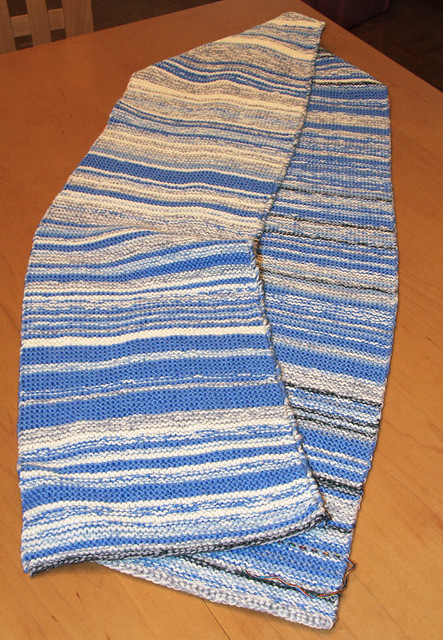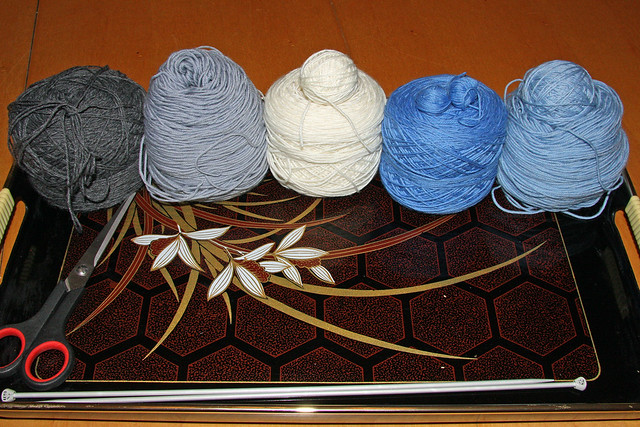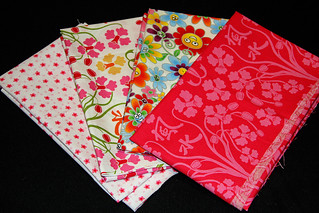 My sky scarf is done! YAY! I can't believe it's been a whole year since I started it. Today I knitted the final two rows. I still need to weave in some ends, but it's off the needles.
My sky scarf is done! YAY! I can't believe it's been a whole year since I started it. Today I knitted the final two rows. I still need to weave in some ends, but it's off the needles.
I actually had mixed emotions about casting off and cutting the strands to secure the last stitch. On one hand it was nice to be done. One the other, this piece was on the needles for a relatively long time. It was a little sad to see it end.
It's by no means perfect. I know I knitted at least one day twice and somehow I ended up with two extra stitches (started with 50, ended with 52). That's not really surprising because I was knitting with two strands of yarn; it was easy to split them or drop one occasionally, which I also did. I corrected some mistakes as I went along, but mostly I didn't notice. Knitting in front of the TV can be distracting.
Anyway, here's the finished scarf:

Here's all of the leftover yarn:

Quite a bit, eh? Two of the skeins (dark blue and white) are the second ones of that colour. I'm still working off the first skein of all of the others.
Since I have lots of yarn leftover, I think I might make another one. Crazy, right? I think it'll be cool to compare the two. If I make it narrower, I should have enough to make it through a whole year. Since the yarn is a tad pricey, I'd really like to use it up and not purchase anymore. Also, I'm going to rethink my choices for certain weather/sky conditions. I'd like to be able to tell overcast from light rain (currently both are white and light grey) as well I'd like to be able represent freezing rain somehow (thanks for mentioning this Heather). Because of these changes, I won't be able to compare the years exactly, but it'll be close enough.
Also, as you can tell better here, a few of the colours, namely the light blue and dark grey, were barely used at all:

I'd like to make more use of them. I'm not sure how yet.
Anyway, I'm going to start recording the sky conditions tomorrow. If I decide that I'm going to make another one for the coming year for sure, both scarves will represent May 1 to April 30. At least that'll be consistent.
I'm still thinking of making a temperature scarf (hosted by Bernat), but I'm stalled at picking the yarn. Heather over at Books and Quilts offered a suggestion as to which yarn I could use, but I'm still waffling. I love her suggestion, but I'm a little worried that the yarn will be too thick to carry the stragglers up the side. If it is, I'll have to cut and rejoin the colours as needed. Can you imagine how many ends that'll leave to weave in? OMG! I'm going to look into it further. I plan to (hope to) use historical data for this one so timing isn't critical, but I really want to stop talking about it and start knitting soon.
By the way, as I post this our rain has turned into snow, flurries for now. According to the forecast , it's supposed to snow overnight and all day tomorrow. *big sigh*. So far, it doesn't look like we'll get as much as the western and northern parts of the province. 5cms instead of 15-20cms. *fingers crossed* A lot of our winter snow pack melted over the past few days because of some (finally!!!!) warm temperatures, however, it's really hard to tell that it's the end of April. It looks and feels like early March. Mother Natures needs a smack up side the head!
Needlework Tuesday is hosted by Heather over at Books and Quilts. Tami over at Just One More Thing... is doing some wonderful quilting. Be sure to visit both of them to see what they've been up to.













